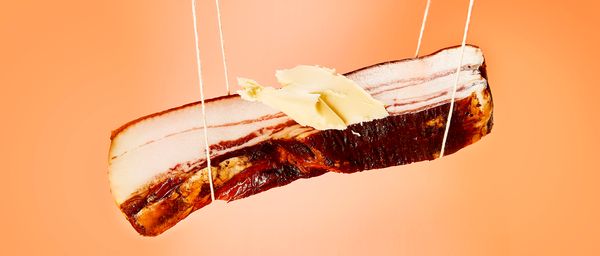
It flatters the tongue, brings ingredients together into silky sauces and can deliver sumptuous chargrilled crispiness. Find out here how your cooking can benefit from using fat the right way.
GRAND-MÈRE’S BUTTERY SAUCE HOLLANDAISE,
Asian street food fried in esame oil, pasta with pesto – fat plays a leading role in every country’s cuisine. But the type, and how it is used, makes the difference. In regions with abundant grazing land, animal fats such as butter are a regular guest at the table; on the Mediterranean, everything wallows in heart-healthy olive oil; whereas in the tropics, food sizzles in pools of sesame, soy or coconut oil. So it’s important to choose fat according to the geographical and cultural origin of the recipe. The various sources act as an ingredient as well as a cooking and seasoning agent. During cooking, the fat enhances the inherent flavour of meat, vegetables and more. On the plate, it ensures a wonderful in-mouth sensation – assuming it’s carefully chosen, applied in the right quantity and adequately prepared.
“Oil in water emulsions always work better when their ingredients are neither too hot or too cold.”
Samin Nosrat, cook and author of »Salt Fat Acid Heat«, Simon & Schuster
Oil exploration: what type is right?
The type of fat used for cooking should be chosen not just by the flavour but first and foremost by the method of cooking. For extremely high temperatures such as frying or deep-frying, fats that stand up well to heat are ideal, for example palm and coconut fats, rapeseed oil, grapeseed oil, corn oil, soy oil or peanut oil. Butter and cold-pressed natural oils from, for example, olives, walnuts or seeds have a significantly lower smoke point and start smoking at just over 120°C. Because this leads to the release of hazardous substances and an undesirable taste, these oils should only be used for sautéing, steaming and flavouring, or in cold cuisine.
A base for mouthwatering sauces . . .
. . . is a combination of fat and liquid. But these two elements resist one another, so they need to be forced together by mechanical means such as whisking or shaking. To stop the ingredients within this delicious liaison going their separate ways within a matter of minutes, an emulsifier is necessary – for example a protein. Take aioli: egg yolk is whisked until fluffy before oil is added, drip-for-drip, while it is whisked igorously until creamy. Garlic, salt and pepper round off the flavour. Please note: protein-rich fat sources, for example milk products and eggs, should always be at room temperature and added gradually while stirring to prevent the protein from curdling.
Crispy crust and juicy texture
Unlike water, frying fats don’t evaporate at 100°C and this is why we use them as a medium to impart a delicious, crispy crust on food by cooking it at high temperatures.
For uniform browning, it’s important to bear in mind that – especially for low-fat ingredients – you need to be generous with the oil. Marbled pieces of meat release their fat during heating, meaning you can hold off on the oil here. But another tip for deep-frying meat, fish, vegetables or batter: every cold ingredient that is added to the hot fat reduces the temperature a little. If you’re planning to fry large quantities at the same time, the ingredient could end up absorbing lots of the cooler oil and not becoming crispy. It’s usually better to work with one portion at a time to maintain a high temperature.


